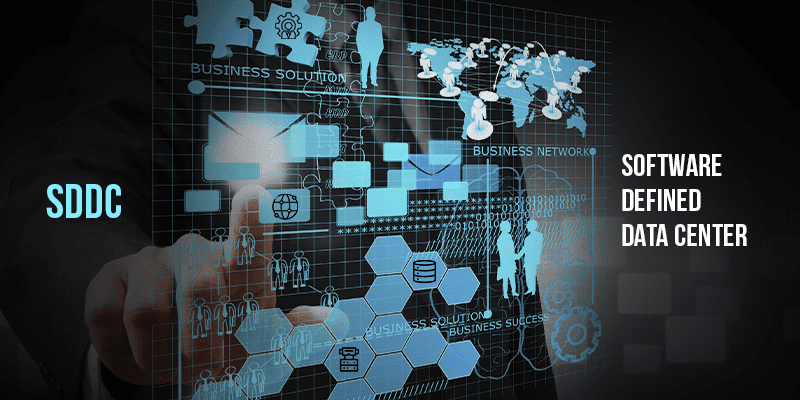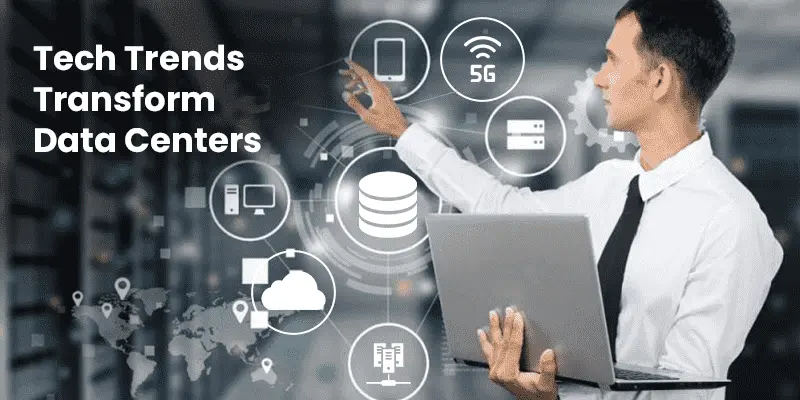
Software Defined Data Center (SDDC): Advantages and Components
Table of Content:
The changing times are constantly leading to higher information demand and Information has established itself as the most important asset for modern organizations today. The advent of technology-driven services along with the ever-increasing digital economy, has led to an exponential growth in data usage and storage. This growth, in turn, has resulted in the need for more data centers worldwide.
The COVID-19 pandemic is not over yet, and it has made us realize the fickleness of life. Amidst this, data centers play a vital role in enabling businesses to reach their customers online and continue delivering their services. Businesses have started to strategize and realize the dynamism of what they can achieve by incorporating data centers into their operations. Modern data centers are equipped with the latest functionalities. If you are also looking to enhance your business’ IT agility and accelerate its IT service delivery, then a Software-Defined Data Center (SDDC) is what you need.
If you are wondering what an SDDC is and why your business needs it, that is exactly what we will be addressing in this post. So, let’s dive in.
What is a Software-Defined Data Center (SDDC)
A Software-Defined Data Center (SDDC) is an ITaaS (IT-as-a-Service) platform. It caters to an organization’s infrastructure, software, or platform requirements. SDDCs utilize software-driven tools and procedures to provide computing and storage services. Unlike a traditional hardware-based data center, an SDDC operates more like a cloud model.
It is also known as a Virtual Data Center (VDC) because it extends virtualization concepts like abstraction, resource pooling, and automation to all its services and resources. All the infrastructural elements such as storage, CPU, networking, and security are virtually delivered as a service in SDDC.
In a conventional hardware-defined data center, if your network infrastructure demands exceed its capacity, the system performance suffers. In the worst scenario, you may well end up crashing the whole network. However, an SDDC can quickly scale up the network capabilities to make room for the increased demands.
An SDDC can host storage devices, servers, security devices, and network equipment. It can be hosted on-premises, with a managed service provider (MSP), or in the cloud (public, private, or hosted.)
Read this also: What is a Managed Service Provider and its Benefits
Key Components of Software Defined Data Center (SDDC)
In a cloud hosted SDDC, the host servers remain in the cloud. Therefore, you can create and configure data centers as per your requirements, without needing to configure or host network equipment physically. An SDDC depends largely upon virtualization technologies for abstracting, pooling, managing, and deploying all data center functionalities.
The following are the key components of an SDDC architecture:
Compute Virtualization or Server Virtualization
Compute virtualization is a well-known SDDC component. It abstracts and pools operating systems and applications from physical servers with the help of a hypervisor. This enables administrators to utilize virtual machines (VMs) to run multiple, different operating systems and applications on a single server.
It enables users to develop software-based computer implementations that can be spun up or down, as and when required, without taking much of the provisioning time. Businesses have been long using this virtualization technology to enhance resource utilization and bring down server sprawl.
Storage Virtualization (SDS)
It is also referred to as Software-Defined Storage (SDS). It pools storage resources by eliminating islands of disconnected storage systems. SDS is a key component that enhances both scalability and flexibility of an SDDC. Basically, you have a storage pool from which you can provision storage whenever you need, often without requiring to purchase fresh capacity.
Storage virtualization also allows you to dynamically allocate the storage, providing each application the capacity it requires on-demand.
Network Virtualization (SDN)
It is also known as Software-Defined Networking (SDN). In a virtualized network, administrators and cloud and networking engineers have a centralized control console. This console enables them to quickly respond to the changing business requirements. It helps them manage and provision networks independently of the underlying physical hardware.
A virtualized network has multiple types of network technologies that are designed to provide more flexibility and agility to the network. This enhanced flexibility and agility support the virtualized storage and server infrastructure of the modern data center. A sophisticated network virtualization solution also facilitates security capabilities to protect networks and isolate workloads.
Automation, Orchestration, and Management
An SDDC utilizes sophisticated automation and management solutions to ensure business-critical functions are working round the clock. This also ensures you need as little IT manpower as possible. Automation and remote management are delivered through a software platform that is accessible from a suitable location, through APIs or web browser access.
Advantages of Software Defined Data Center
There are numerous advantages that SDDCs offer over traditional data centers. Industry experts believe that the inevitability of moving to an SDDC from a conventional data center is just around the corner. With the increasing popularity of IT-as-a-service, this does seem true.
You need an SDDC for your organization because of the following major advantages it offers:
Enhanced Agility
SDDCs offer many advantages that make your business more agile. The enhanced agility is the result of improvements in three key areas of your business – balance, adaptability, and flexibility.
An SDDC consolidates duplicate functions to enhance the overall productivity of your business. This enables you to direct your IT resources to solve other important issues related to your business. This, in turn, enhances the agility of your business.
Moreover, an SDDC helps you increase your Return on Investment (ROI). That way, you have more funds to invest in your long-term business strategies and innovations.
Reduced Costs
An SDDC costs you less to operate compared to a brick-and-mortar data center. Traditional data centers have operational requirements such as building leases and hardware. They also need round-the-clock employees and security.
Even if you decide to house your data in-house, you need extra IT manpower and expensive hardware equipment. On the other hand, a cloud SDDC charges you on a monthly basis. These charges are affordable. Even if you don’t have a big budget for technological innovations, you can still afford an SDDC.
No Hardware Dependency
A cloud SDDC enables you to eliminate proprietary hardware dependency from your system. Just like a Google car is independent of floor pedals, an SDDC is independent of the command-line interface.
And due to Commoditized hardware in SDDC, it eliminates the need for expensive training required for operating highly specialized vendor hardware. Moreover, an SDDC frees up all your IT resources to help you focus on adding more value to your business and its bottom line.
Simplified Data Center Management
Unlike a conventional data center that requires huge effort, time, and money for successful management, an allows you to manage everything with just a few clicks or taps. A single dashboard allows you to monitor data, update systems, and allocate additional storage resources.
Enhanced Scalability
The design of a cloud based SDDC allows you to scale your functionalities according to your business requirements. Increasing your storage capacity or adding more functions is fairly simple. Just reach out to your data facility and they will oblige immediately. Moreover, you won’t be required to pay anything upfront. As you choose to scale up or down, your monthly service quote will be revised accordingly.
A traditional, brick-and-mortar data center can only be scaled by making additional room for more servers, procuring expensive hardware and software, and employing enough manpower to make the transition. This not only costs more but takes a lot of time as well.
Automation and Orchestration
Rather than grappling through complex IT services, you can improve your business workflow by utilizing the repeatable solutions offered by an SDDC. Automation, Orchestration, and abstraction of various resources into software programs are the principal characteristics of an SDDC.
Software, by its nature, is comparably more reliable than humans. This is the reason why an SDDC is more responsive and agile in all measures as against the legacy data center.
What Lies Ahead
It is anticipated that SDDC will significantly impact the data center computing sector. As one can use resources from different data centers to run an application if the application layer can be abstracted from the underlying physical hardware.
The Software Defined Data Center (SDDC) is facilitated on virtual architecture shared by private, public, and hybrid clouds, allowing for seamless resource migration on demand.
As SDDC develops, software will increasingly abstract data center technologies, necessitating a rethinking of how businesses protect their data. Greater communication and cooperation between security and virtualization teams can aid in detecting and neutralizing threats. By building security into software, businesses can respond to new threats with more agility. An instance of this is enforcing security measures that take into account the app, its data, or its users.
Conclusion
Conventional data centers have long been facing the challenge of finding new methods to offer more computational resources and storage capacity. That too within the restricted physical dimensions of the facility. But, technology, like always, is playing a vital role in transforming data centers in 2022. The advent of virtualization technologies like software-defined compute, network, and storage has made way for a Software Defined Data Center.
If you too want to make your business more agile, productive, and scalable in a cost-efficient manner, then a Software-Defined Data Center is the way forward. Persisting with a hardware-defined data center may prove to be extremely disadvantageous for your business, allowing your counterparts to have a competitive edge over you.
FAQs
What is VMWare software-defined Datacenter
VMWare is like a container with all the inventory elements that are necessary to finish a fully functional environment for running virtual machines. It allows you to establish various data centers in order to organize distinct sets of environments to cater to the requirements of a variety of users.







